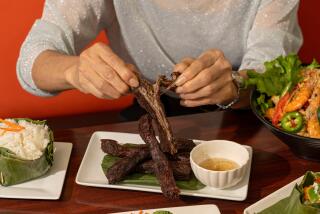Bet the Pot
- Share via
“During the past 30 years, I’ve published more of these recipes than anyone I know,” Paula Wolfert says, laughing. The queen of slow cooking and author of seven books, including 2003’s “The Slow Mediterranean Kitchen,” is referring to beef stew, daube in particular.
Even small talk with Wolfert is a discourse, for few writers possess her command of the food lexicon and her indefatigable curiosity about all things edible. Get her started, and you’ll end up knowing more about daubes than you thought possible. For example, did you know that the best beef daubes are made with three kinds of meat: gelatinous shin for body, short ribs for flavor and chuck for firmness? Or that daube is a method of cooking as well as the name of the dish? Or that the moniker is relatively new? People in southern France were happy to eat the dish for centuries and felt no compunction to christen it until 1723.
For the uninitiated, daubes are wine-based stews made from almost anything--beef and goat to fish and octopus--that are slowly cooked for hours in a tightly sealed pot. Now this may sound like your Sunday afternoon brisket or my mom’s carne asada, but Wolfert is nearly dictatorial in her demand for authenticity. “A daube is best made in a daubiere,” she says. “The shape of the pot makes sure condensation builds and no evaporation occurs, so everything stays moist.”
That’s all fine and good, but what can the rest of us do, who, unlike her, haven’t trekked the Hautes-Alpes in Aubagne, France, for the real deal?
“A Le Creuset pot will work,” she concedes reluctantly. Then she brightens: “But there’s a trick in every recipe.” She explains that if you dampen a circle of parchment paper and place it on top of the food, it simulates a real daubiere by reducing evaporation, making for a richer daube.
She warns cooks to plan ahead, because daubes are best eaten the next day or even the day after. “It’s great to make on a Sunday and eat the rest of the week,” she says. In Avignon, France, where Wolfert conducted research for some of her books, traditional lamb daubes are reheated several times before serving. “It’s the only way to bring out all the flavors,” she insists.
Ask her which daube is her favorite, and she harrumphs. “Please. That’s like having lots of kids and asking me which I love the most. It’s not fair. I love them all.”
Her culinary stream-of-consciousness suddenly stops. All this talk has made her hungry, and she hurries me off the phone. Apparently lunch takes precedence in her house.
*
Daube de Boeuf Provencale
Adapted from “Mediterranean Cooking,” by Paula Wolfert
Serves 6
1/2 cup carrots, peeled in 1/2-inch slices
1/4 cup sliced celery
1/4 cup chopped onion
3 tablespoons olive oil
2 tablespoons coarsely chopped mixed fresh herbs (parsley, thyme, rosemary or savory and dry bay leaf)
2 teaspoons chopped garlic
2 cups dry red or white wine
Salt to taste
12 black peppercorns
1 pound beef shank (meat left in one piece)
1 pound beef short ribs
1 pound well-marbled beef chuck, cut into 2- to 3-inch pieces
2 medium onions, thinly sliced
1/2 cup (3 ounces) pancetta, diced into 1/4-inch pieces
1 28-ounce can and 14.5-ounce can tomatoes, seeded and chopped (5 cups)
Bouquet garni of dry bay leaf, 5 parsley sprigs and 2 thyme sprigs, tied together in cheesecloth
1 tablespoon orange zest
Parchment paper cut to fit the inside diameter of the pot
1/4 pound fresh mushrooms, thinly sliced
2 dozen brine-cured black olives, rinsed and pitted
2 tablespoons chopped parsley
In a small skillet, saute carrots, celery and onion in olive oil over low heat for 5 minutes. Add herbs and garlic and continue cooking until the flavors are released, about 1 minute. Add wine, salt and peppercorns. Bring liquid to a boil, then reduce and simmer 10 to 15 minutes. Remove from heat and allow to cool completely. Place beef cuts in a bowl and add cooled marinade. Cover with foil and refrigerate overnight, turning the meat once or twice.
Preheat the oven to 350 degrees. Place meat and marinade in a large, heavy casserole or Dutch oven with a tight-fitting lid. Scatter with sliced onions, then add pancetta, tomatoes, bouquet garni and orange zest. Wet parchment circle and place it on top, pressing down to remove any air bubbles. Cover and cook for 1 hour. Lower the temperature to 250 degrees and cook an additional 3 to 4 hours, until meat easily falls apart.
Set pot on top of stove over very low heat. Remove parchment and stir in mushrooms and olives. Cook until mushrooms are tender, about 10 minutes. Remove bouquet garni and bones, then skim fat from the top of the cooking liquid. Adjust seasoning. Sprinkle with chopped parsley and serve over cooked noodles.
*
David Leite last wrote for the magazine about holiday dinners.


